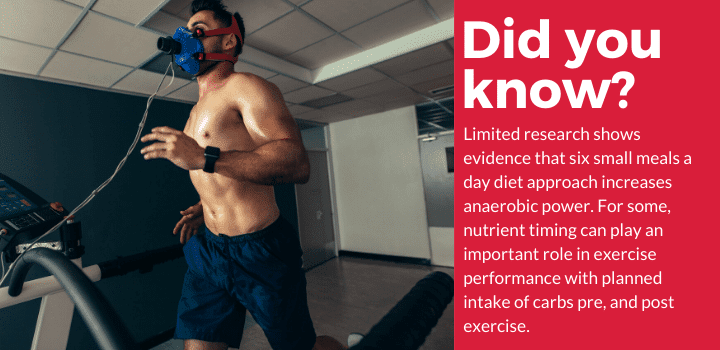Knowing how much to eat and what we should be eating are the two biggest concerns for any athlete looking to improve their performance.
The next biggest question, and that which is arguably the most debated, is when and how often we eat?
In this article we’re going to cover the two largest camps in this debate; intermittent fasting vs. smaller meals throughout the day and detail which may be superior or even how both strategies can be of benefit depending on the person in question.
Related Read: Intermittent Fasting – The End All, Be All Guide For Beginners
Quick Navigation
Fasting vs. 6 smaller meals a day: Which is better?
How does fasting fair when it comes to athletic performance?
How does fasting work
Fasting isn’t just some new fad that was conjured up to help fight the good fight of weight management; fasting has been around for millennia and has a history rooted in both cultural and religious backgrounds (Ramadan is one such example of fasting that is followed by millions of people all at the same time).
More recently however, it has been made popular for its utility as a weight management tool. Gradually increasing in popularity in the 90s and early 2000s before exploding onto the scene following the media frenzy around the 5:2 diet (introduced by Dr Michael Mosley).
Read Also: Managing Your Hunger While On Keto Diet
This was the general public’s first introduction to fasting, however the scientific world has been exploring the use of fasting, not just as a weight management tool, but as a means to improve many more markers of health (as well as protect these long term) for a lot longer.
What has made the study of fasting so intriguing is the variety of strategies one can pick and choose to employ to achieve a state of fasting.
At its core, it is very simple; you endure an elongated period of time between each meal or eating window, achieving a “fasted state”. Strategies include; restricted eating windows on a given day (allowing yourself only four hours that day in which you can eat for example), full day fasts, multi-day fasts and even following very restricted eating on one or two days a week (restricting yourself to below a certain number of calories, however the validity of this as a traditional “fast” is questionable).
Related Read: The 24 Hour Fast – Quickest Way To Lose Stubborn Fat
The benefits of fasting
Ok, so the question I’m sure you’re all wondering “Is fasting any good?”
Now, while that’s a very open-ended question and to answer “Is it any good?” would depend on the context of what it’s good for, the answer, generally speaking, would be yes. Yes, because it’s an incredibly versatile eating strategy that has been associated with a range of health benefits that stretch far beyond weight management.
In fact, fasting has been associated with weight loss, improving metabolic markers of diabetes, lowering the risk of heart disease and even having an “anti-aging” effect.
It has also been associated with improved blood cholesterol and triglyceride levels, reduced systemic inflammation and may even have a beneficial effect on our gut microbiome!
Fasting vs. 6 smaller meals a day: Which is better?
To determine which eating approach is superior we have to first understand the basic theoretical concepts underlining both. We now have a well-versed understanding of fasting, but what is the thought behind six smaller meals a day as opposed to three larger “core” meals?

mini meals
When we eat our metabolic rate increases; this is because we are now in a state where we have to break down the food we’ve just eaten. The thought behind eating six smaller meals a day as opposed to three larger ones is that it’ll increase our metabolic rate, in turn increasing energy expenditure and acting as a means for us to better manage our weight.
Read Also: Five Best Frozen Meal Delivery Services
Much of the work around meal frequency has been contradictory; just as many studies show that it may benefit weight loss and body composition as those which oppose this effect.
This is likely due to the fact many of these studies did not control the calorie intake of the participants. Calorie intake will always dictate the effectiveness of a weight loss approach (it’s just some strategies make managing your calories and or achieving a calorie deficit easier for some people).
The theory that more frequent smaller meals “stokes the metabolic fire” has also been fairly debunked. Research has shown on a number of occasions that more frequent meals do not statistically increase metabolic rate (1,2,3). In fact, it appears more frequent meals may benefit weight loss / management thanks to their effect on improving satiety / reducing hunger.
Ultimately, both fasting and consuming 6 smaller meals a day do however appear to be viable weight loss strategies. However, neither appear to have a “magical” effect, it’s simply a matter of the individual implementing the strategy and their own personal preference for which approach is more sustainable.
How does fasting fair when it comes to athletic performance?
The only way to really measure how these two strategies stack up when it comes to affecting athletic performance, is to investigate their respective impact on the three pillars of athletics; exercise / athletic performance itself, recovery and body composition.
Read Also: Freshly Meal Service Review
Performance
Ultimately, performance will be predicated on the content of the diet. If the athlete is not eating enough, or indeed the required quality / nutrient dense foods, the timing and or frequency of their eating pattern will be fairly unimportant.

That being said, the pool of research comparing the two and their respective effect on athletic performance is limited. A recent 2020 meta-analysis (a summation of all the available data on the subject) investigated fasting, splitting it into studies that revolved around Ramadan or time-restricted feeding (TRF).
The researchers found that neither fasting protocol negatively affected muscle strength or anaerobic capacity. They did find that Ramadan may impact aerobic capacity negatively but in contrast to this TRF may actually improve aerobic capacity.
When we look at performance related outcomes in the six small meals bracket, the research here is even more limited. There is some evidence to show that it may increase anaerobic power however a lot more work needs to be done in this field.
Related Read: Trifecta Nutrition Meal Prep For Athletes – Review
In theory however, nutrient timing may be more feasible with the six small meals approach. Nutrient timing can play an important role in exercise performance with planned intake of carbohydrate (and other nutrients) pre-exercise and during shown to improve performance. However, even in this instance, there are those who perform better fasted during exercise, with some even experience gastrointestinal discomfort, negatively impacting performance!
Recovery
Both strategies have their own unique merits when it comes to recovery. Again, in the grand scheme of things, recovery will be determined by the quality of the foods you include in your diet as well as the quantity of them, as well as other contributing factors like sleep and stress management.
Fasting has a unique benefit to recovery from exercise in that it may reduce inflammation. One study has directly investigated this link. Albeit a small study, and one that would lead us to dig deeper and research further, the researchers did find that overnight fasting may reduce inflammation and contribute to muscle repair after exercise.
Read Also: Post Workout Tips, Supplements, And Products For Women
However, fasting as a strategy for enhanced recovery has been scrutinized. Researchers have stated that fasting, particularly approaches like Ramadan or those similar, will challenge the athlete’s ability to recover optimally between exercise sessions undertaken during the fast or from day to day. Ultimately, the restricted eating period should be timed in a way that it does not interfere with nutritional strategies designed to optimize recovery; this may be difficult for some fasting dieters however and not always practical, inhibiting their ability to recover adequately.
Six small meals may actually have the upper hand in this argument, especially when we consider nutrient timing and the additional benefit of protein distribution throughout the day.
With careful planning, an athlete can plan to have a pre- and post-exercise meal. If these are focused around nutrients designed to improve performance and recovery then ultimately, we’d have to assume better results for both when compared to fasting. Again, this may not be present in all cases, but research does favor the importance of nutrient timing in recovery, particularly in regards to providing a protein source post-exercise, how this can stimulate muscle protein synthesis which, in turn, accelerates the recovery process.
Read Also: Best Nuts For A Keto Diet
It is also worth highlighting how having six small meals may also be more optimal for protein distribution. Ingesting a 20–40 g protein dose of a high-quality source every three to four hours appears to most favourably affect MPS rates when compared to other dietary patterns.
Body composition
Both strategies appear to be of benefit to both athletic and non-athletic groups looking to improve body composition. When performed correctly both approaches to dieting have been effectively able to;
Reduce total body fat percentage (fasting and 6 small meals)
Increase lean body mass (fasting and 6 small meals)
Suppress lean body mass loss during a calorie deficit (fasting and 6 small meals)
Related Read: BistroMD’s Doctor Designed Meal Prep For Weight Loss Review
Both fasting and providing six smaller meals may increase fat oxidation. Research has shown that fasted training leads to a preferential use of stored fat over carbohydrate for energy while also showing that fat oxidation is maintained with adequate post-workout nutrition (particularly the provision of high-quality protein).
This may in turn favor fasting for body composition if the individual can time it so that their eating window follows training and allows for them to get adequate post-workout nutrition.
Overview and conclusion
Both approaches, if conducted correctly, can benefit, not just general members of the public in their never-ending quest to manage weight, but also athletes and their drive to enhance their performance while optimizing recovery and body composition.
Whilst each offers unique benefits for you as the reader to weigh up, it’d be hard for us to definitively say “this one is best”; instead, why don’t you decide?
Ultimately, the best approach is the one that is most practical for your lifestyle, sustainable while also helping you achieve whatever your given goals are. Both approaches can help manage weight, enhance performance, optimize recovery and improve body composition. However, both can also hinder all of these factors if you don’t get the fundamental qualities of any approach right; how much you should be eating (dependent on your goals) and the quality of food you’re eating and from which sources.
There’ll be those who prefer fasting. There’ll be those who prefer 6 smaller meals. Neither is inherently “wrong”, it all comes down to personal preference. We’d advise you give both camps a try and see which works best; become your own science project!

